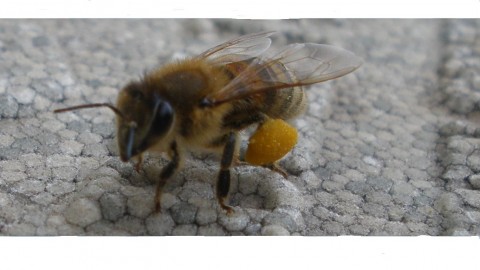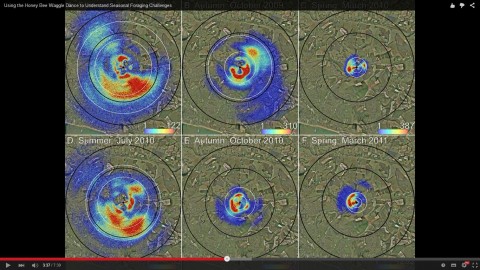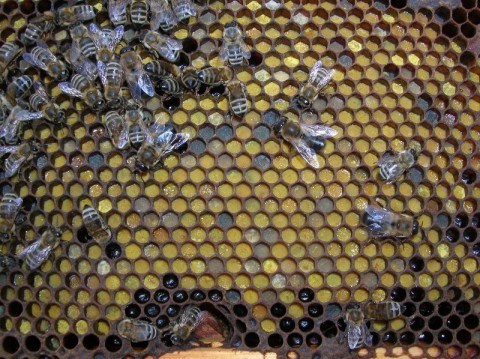 Abraham Lincoln
If given the truth, the people can be depended upon to meet any national crisis...
Abraham Lincoln
If given the truth, the people can be depended upon to meet any national crisis...
 Guildford news...
for Guildford people, brought to you by Guildford reporters - Guildford's own news service
Guildford news...
for Guildford people, brought to you by Guildford reporters - Guildford's own news service
Beekeeper’s Notes November 2015 – Waggle Dance Detectives
Published on: 1 Nov, 2015
Updated on: 1 Nov, 2015
Hugh Coakley writes about the astounding distances that bees fly and how our sleuth academics have worked it out.
It isn’t often that we have the pleasure of meeting and hearing a real expert.
I attended a talk recently by Professor Ratniek of Sussex University. It was organised by Surrey Beekeepers and it was attended exclusively, not surprisingly, by local beekeepers. They all knew a thing or two. But you know a real expert when they open up complex ideas and then put them across in a simple, understandable way.
Professor Ratniek is such a person.
He heads up LASI at Sussex University – not the dog but the Laboratory of Apiculture and Social Insects.
Prof Ratniek and his trusty researchers have been putting on their Sherlock Holmes deer stalker hats and getting out their magnifying glasses to view thousands of bee waggle dances. Bees use the waggle dance to tell their fellow bees where they have found a promising food source.`

This bee landing in my apiary in late October knew exactly where to forage as she has come back fully laden with pollen. The odd looking surface is the polystyrene material that the hive is made from.
By decoding the dances, LASI built up a picture of where the bees were telling their bee mates to go to forage, thus deducing where the bees actually went to collect nectar and pollen. A nifty bit of detective work by our academics – using the bees to do their own leg work.
Have a look at some waggle dances videos, click on the youtube and national geograhic links.
The surprising thing was the results. Bees were travelling huge distances but also travelling much more in the summer than in the spring to find food .

‘Heat map’ of bees foraging throughout the year. They travel up to 10kms in the summer compared to an average 1km in the spring
The picture above shows a plot of where the dancing bees were telling their nest mates to go. On the right, the plot shows that in spring in 2010 and 2011 the bees were flying about a kilometre on average to forage.
That is amazing itself. These tiny creatures were flying 1km there, collecting a basketful of pollen and then flying 1km back.
In the summer in those same years – shown on the left, the bees were flying three kilometres on average to their food destination and as far as 10 kilometres to bring home the bacon (so to speak). That is, to be quite clear, 10kms there and 10km back! I think that is a marvel.
In the autumn, it is somewhere in-between.
The distances flown by the bees are astounding but why do the bees have to fly so much further in the summer than the spring or even the autumn?
The answer is thought to be that in the spring we have a huge abundance of flowers from dandelions to crocuses to fruit trees and other trees. In the autumn, we have ivy flowering. It is a very discrete flower, most people don’t even know that it flowers but it is plentiful and the bees love it.
In the summer though there are fewer flowers about. The hay meadows of the past have largely gone and the way we farm to feed our prosperous mouths means a monoculture with not a flower to be seen, acre after acre. There is also a lot of competition about as well, with many more insects such as bumble bees at their maximum population in the summer.

Bees in my apiary over the last couple of weeks queuing up to get into the hive to offload their pollen shopping.
So, our wonderful academics have shown that the bees fly astonishing distances to provide for their hive but also that habitat loss has a real impact on the bees. And they have demonstrated it so beautifully and simply.
PS: Another reminder to those who would like to keep bees; Guildford Beekeepers will be running their next theory course for new beekeepers on January 7, running to February 25.
The courses are in the evenings at Birtley House in Bramley. Cost is £80. It is an excellent introduction to what you will need to do if you start to keep bees.
The practical beekeeping course follows on. If you are interested, email Jane Hall on janeandhughhall@aol.com.
Responses to Beekeeper’s Notes November 2015 – Waggle Dance Detectives
Leave a Comment Cancel reply
Please see our comments policy. All comments are moderated and may take time to appear. Full names, or at least initial and surname, must be given.
Click on cartoon for Dragon story: Public Asked for Views on SCC’s Proposal for Reduced Speed Limits


Recent Articles
- A281 At Shalford Has Now Reopened Following Repairs To Damaged Roof
- Frimley Park at the Beginning of the Hospital Rebuild Queue
- Letter: Council Has Quietly Relieved Developer of £Million Obligation
- The Royal Surrey Hospital to Open Its Doors to the Public for Community Open Day
- Summary of GBC Planning Decisions – June 18, 2025
- Letter: Reflecting on the Juneja Case Shows the Importance of the Monitoring Officer Role
- New Electric Trains Now Arriving at Guildford – 100 Years After the First One Did
- Woman Pedestrian Dies on A31 After Collision With a Truck
- Road Closed After Lorry Hits Railway Bridge
- The Bishop’s Leap of Faith – From the Top of the Cathedral


Recent Comments
- H Trevor Jones on Residents Urged to Have Their Say on the Changing Shape of Surrey’s Local Government
- Alistair Smith on A281 At Shalford Has Now Reopened Following Repairs To Damaged Roof
- Roland Dunster on GBC’s Plan For a Thriving Guildford ‘Is Our Promise to Residents’ Says Council Leader
- Richard Benson on GBC’s Plan For a Thriving Guildford ‘Is Our Promise to Residents’ Says Council Leader
- Nigel Base on Letter: Recreational Rowing Might Be the Answer
- Anna Windebank on GBC’s Plan For a Thriving Guildford ‘Is Our Promise to Residents’ Says Council Leader
Search in Site
Media Gallery
Dragon Interview: Local Artist Leaves Her Mark At One of England’s Most Historic Buildings
January 21, 2023 / No Comment / Read MoreDragon Interview: Lib Dem Planning Chair: ‘Current Policy Doesn’t Work for Local People’
January 19, 2023 / No Comment / Read MoreA3 Tunnel in Guildford ‘Necessary’ for New Homes, Says Guildford’s MP
January 10, 2023 / No Comment / Read More‘Madness’ for London Road Scheme to Go Ahead Against ‘Huge Opposition’, Says SCC Leader
January 6, 2023 / No Comment / Read MoreCouncillor’s Son Starts Campaign for More Consultation on North Street Plan
December 30, 2022 / No Comment / Read MoreCounty Council Climbs Down Over London Road Works – Further ‘Engagement’ Period Announced
December 14, 2022 / No Comment / Read MoreDragon Interview: GBC Reaction to the Government’s Expected Decision to Relax Housing Targets
December 7, 2022 / No Comment / Read MoreHow Can Our Town Centre Businesses Recover? Watch the Shop Front Debate
May 18, 2020 / No Comment / Read More







Harry Eve
November 1, 2015 at 8:26 am
Absolutely fascinating. Ivy is one of the best plants we have for wildlife providing shelter as well as nectar.
It is also one of the larval foodplants for the holly blue butterfly.
Flowering ivy is well worth watching in the autumn for the wide variety of insects – butterflies and hoverflies, as well as bees – visiting the flowers.
Hay meadows are summer cut which means that honeybees and bumblebees are very suddenly deprived of a wide area of flowers that they are used to foraging in.
The purpose of hay meadows was always to provide hay – not support biodiversity – but this mattered less when there were still plenty of meadows, cut at different times, and reasonably close together.
That time is long gone in South-east England. Reptiles and small mammals are also exposed to predation if not killed during the cut.
Flower-rich roadsides are often cut just at the time when they are doing most to support our wildlife.
If anyone is thinking about creating a wildflower meadow it’s well worth thinking about these points and aim to create a wildlife meadow instead.
jim Allen
November 1, 2015 at 10:32 am
Interested in Bees? in 1989 Intermec (the barcode company) I worked for Bar Coded Bees – the report can be found at
http://www.people.com/people/archive/article/0,,20120351,00.html
It makes fascinating reading both about Bees and the then ‘modern’ technology of Bar Codes…